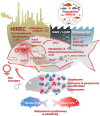Netting the Stress Responses in Fish
- PMID: 30809193
- PMCID: PMC6379254
- DOI: 10.3389/fendo.2019.00062
Netting the Stress Responses in Fish
Abstract
In the last decade, the concept of animal stress has been stressed thin to accommodate the effects of short-term changes in cell and tissue physiology, major behavioral syndromes in individuals and ecological disturbances in populations. Seyle's definition of stress as "the nonspecific (common) result of any demand upon the body" now encompasses homeostasis in a broader sense, including all the hierarchical levels in a networked biological system. The heterogeneity of stress responses thus varies within individuals, and stressors become multimodal in terms of typology, source and effects, as well as the responses that each individual elicits to cope with the disturbance. In fish, the time course of changes after stress strongly depends on several factors, including the stressful experiences in early life, the vertical transmission of stressful-prone phenotypes, the degree of individual phenotypic plasticity, the robustness and variety of the epigenetic network related to environmentally induced changes, and the intrinsic behavioral responses (individuality/personality) of each individual. The hierarchical heterogeneity of stress responses demands a code that may decrypt and simplify the analysis of both proximate and evolutionary causes of a particular stress phenotype. We propose an analytical framework, the stressotope, defined as an adaptive scenario dominated by common environmental selective pressures that elicit common multilevel acute stress-induced responses and produce a measurable allostatic load in the organism. The stressotope may constitute a blueprint of embedded interactions between stress-related variations in cell states, molecular mediators and systemic networks, a map of circuits that reflect the inherited and acquired stress responses in an ever-changing, microorganismal-loaded medium. Several features of the proposed model are discussed as a starting point to pin down the maximum common stress responses across immune-neuroendocrine relevant physiological levels and scenarios, including the characterization of behavioral responses, in fish.
Keywords: fish; phenomics; plasticity; stress; stressotope; teleost; transcriptomics.
Figures


References
-
- Roberts RJ. Fish Pathology. Oxford: John Wiley & Sons; (2012).
-
- Schreck CB, Tort L, Farrell A, Brauner C. (editors). The concept of stress in fish. Fish Physiology. London: Elsevier; p. 1–34.
Publication types
LinkOut - more resources
Full Text Sources
Other Literature Sources

